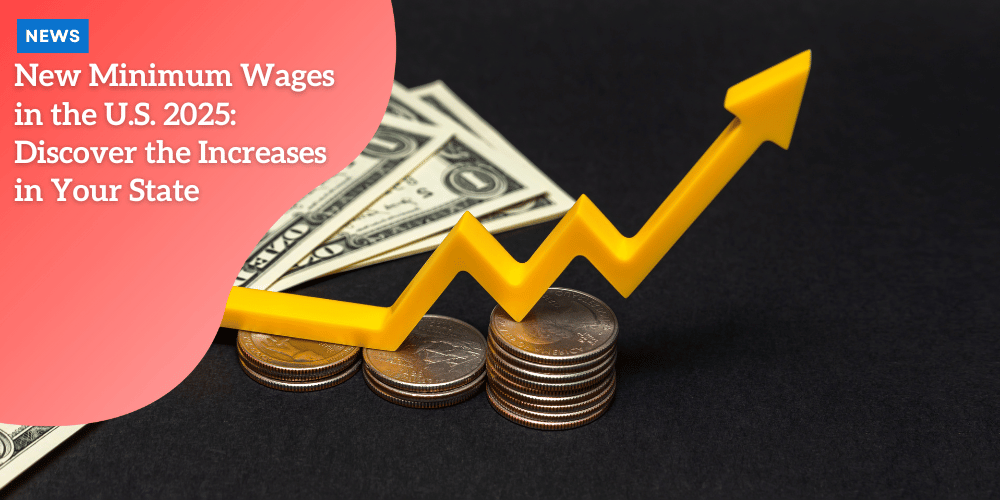New Minimum Wages in the U.S. 2025: Discover the Increases in Your State

Federal Minimum Wage Status and State Initiatives
The federal minimum wage has been an unwavering constant at $7.25 since 2009, reflecting a stagnation that has endured for 15 years.
Anúncios
Despite numerous legislative attempts, proposals to increase the minimum wage have failed to gain traction at the federal level.
This stagnation has reignited debates and prompted action at the state level.
States Taking the Lead
While the federal minimum wage remains unchanged, 30 states and Washington D.C.
Anúncios
have taken steps to establish higher minimum wages for their workers.
These states recognize the necessity of ensuring better living standards and addressing the economic realities many workers face today.
States such as California, Washington, and Massachusetts lead with substantially higher minimum wages.
Anúncios
For example, California’s minimum wage for large employers is $16, whereas Washington’s minimum wage is $15.74 CNN.
These increases reflect a broader acknowledgment that the federal floor is inadequate to meet the rising living costs.
Automatic Annual Increases
A growing number of states have implemented mechanisms for automatic annual wage increases.
These mechanisms are typically tied to the cost of living and inflation rates, ensuring that workers’ wages keep pace with economic changes.
This system of automatic adjustments helps protect workers from the eroding effects of inflation and provides a degree of predictability for employers.
For instance:
- 💰Alaska has a provision for adjusting its minimum wage based on inflation measured by the Consumer Price Index (CPI).
- 💰Florida passed a constitutional amendment in 2020 that mandates annual adjustments following a specific schedule until the minimum wage reaches $15 per hour in 2026, followed by inflation-based adjustments NBC News.
Regional Approaches to Wage Increases
The variation in how states manage minimum wage increases highlights regional differences.
Western states, such as California and Washington, have set higher wage standards compared to southeastern states where the cost of living may be lower but wage increases have been more modest.
Notably, New York employs a different strategy by setting distinct minimum wage levels for New York City (NYC), Long Island, and Westchester, which are higher than those in upstate areas to reflect regional cost differences.
This nuanced approach acknowledges the distinct economic landscapes within the state.
Transition to Upcoming Updates
As federal action continues to stall, state-led initiatives are crucial in fortifying wage growth.
With several states planning significant wage hikes in the new year and beyond, it’s evident that the efforts to adjust wages in accordance with economic realities are far from over.
This regional momentum signals an ongoing trend where states experiment with and implement strategies responsive to their unique economic climates, ensuring that any changes cater specifically to the needs of their residents.
These initiatives set the stage for a potential broader shift in how wages are managed nationally.
Continuing to monitor these state-led changes provides insight into the evolving landscape of minimum wage policies, ensuring that both workers and employers stay informed and prepared for upcoming adjustments.
January 2025 Minimum Wage Increases
Starting January 1, 2025, a substantial wave of minimum wage increases will take effect across the United States, with 21 states scheduled to raise their minimum wages.
These changes reflect state-level efforts to combat the stagnation of the federal minimum wage, which has remained at $7.25 per hour since 2009.
| State | Current Minimum Wage | New Minimum Wage (January 2025) |
|---|---|---|
| California | $16.00 | $16.50 |
| Connecticut | $15.69 | $16.35 |
| Washington | $16.00 | $16.66 |
| Delaware | $13.25 | $15.00 |
| Illinois | $14.00 | $15.00 |
Continued State-Led Efforts
These substantial increases in minimum wage highlight ongoing state-led efforts to provide economic relief and improve living standards for workers.
While the federal minimum wage remains unchanged, these state initiatives demonstrate a trend towards ensuring higher and more equitable pay.
As we witness these changes, it becomes evident that states are taking varied and dynamic approaches to wage policy, trying to bridge the gap left by federal inaction.
These efforts show a strong commitment to addressing wage stagnation and ensuring that workers can meet their basic needs.
Through continued state-level action and automatic adjustment mechanisms, the trajectory towards higher minimum wages seems set to persist, shaping the economic landscape for years to come.
Regional Variations in Wage Increases
The variations in minimum wage increases across the United States highlight the regional differences in economic conditions and living costs.
These differences are evident in the scheduled changes for January 2025, with several states leading the way in setting higher wage standards than the federal minimum wage.
New York: Varied Rates Based on Locale
New York is a notable example of how minimum wage rates can differ within a single state.
In January 2025, New York City, Long Island, and Westchester will see a minimum wage rise to $16.50 per hour.
Meanwhile, the rest of the state will have a lower, but still significant, increase to $15.50 per hour.
This variation acknowledges the higher cost of living in the metropolitan areas compared to other regions of the state.
Western States Leading the Way
The Western states are generally offering some of the highest minimum wages.
For example, California’s minimum wage will reach $16.50 per hour, while Washington will lead with $16.66 per hour.
These increases reflect the higher cost of living in these states, where housing and other living expenses are typically higher than the national average.
Modest Increases in the Southeastern States
On the other end of the spectrum, Southeastern states are showing more modest increases in their minimum wages.
These states often have lower costs of living compared to the Western and Northeastern regions.
For instance, states like Florida have planned their increases more conservatively.
While these increases still represent progress, they highlight the economic disparities across different regions of the country.
Transition to Mid-Year and Late 2025 Increases
As we move into mid-year and late 2025, other states will implement their scheduled wage adjustments. This staggered approach allows for a smoother economic adaptation to the new wage standards.
 Salary
Salary
States like Michigan, Oregon, and Washington D.C. are planning for July 2025 increases, while Florida has set its next adjustment for September 2025.
These transitions ensure that wage growth continues to be addressed throughout the year, accommodating the varying economic rhythms of different states.
Mid-Year and Late 2025 Wage Adjustments
While many states are poised for minimum wage hikes starting January 1, 2025, others have scheduled their increases for later in the year.
This phased approach allows these states to adapt economically and make considered adjustments to their minimum wage standards.
July 2025 Wage Increases
Three significant regions, Michigan, Oregon, and Washington D.C., plan to adjust their minimum wages in the middle of the year, effective July 1, 2025.
These mid-year adjustments provide local governments time to assess economic conditions and make necessary calibrations.
- 💰Michigan: The increase in Michigan to $10.56 per hour was cautiously planned to align with economic trends observed at the start of the year. This approach helps businesses and workers adapt smoothly without dramatic shifts.
- 💰Oregon: Oregon aims to maintain its pace with the record-high wages of Western states while ensuring its economy can handle higher rates. This timing allows the state to respond to any fiscal feedback from earlier in the year.
- 💰Washington D.C.: The rise in Washington D.C. reflects the city’s ongoing commitment to addressing high living costs and economic disparities. This planned increase also allows for assessments of the shifts brought by the January 2025 increases in adjacent states like Virginia.
September 2025 Wage Adjustment
Florida has taken a unique approach by scheduling its wage increase for September 2025.
This allows for a comprehensive economic analysis after the peak tourist season, which is essential given the state’s dependence on tourism.
- 💰Florida: This strategic timing ensures that insights from the summer can inform wage decisions, allowing both employers and employees to adapt to the seasonal economic variations that characterize the state.
Staggered Implementation for Economic Adaptation
By staggering these increases throughout the year, states like Michigan, Oregon, Washington D.C., and Florida demonstrate a commitment to economic stability.
This approach allows for more manageable transitions for businesses and workers alike, mitigating the shock that might come from a simultaneous nationwide hike.
This staggered method not only considers local economic conditions but also caters to the unique circumstances of each state, ensuring a gradual adaptation process.
The thoughtful scheduling of these wage increases is a testament to the complex balancing act required to support workers while considering the health of local economies.
As we look toward the future, these measured steps pave the way for continued discussions and adaptations in minimum wage policies across the United States.
Impact and Future Outlook
State-Led Efforts Continue to Address Wage Growth
In recent years, numerous states have taken proactive measures to boost minimum wage levels, responding to the long-standing inaction at the federal level.
The federal minimum wage remains fixed at $7.25 per hour, a figure unchanged since 2009.
Meanwhile, 30 states and Washington D.C. have already established higher wage floors to better reflect the economic realities faced by their residents.
This localized approach to wage policy highlights an important trend: states are not waiting for federal guidelines to ensure fair compensation for workers.
The significance of these state-led efforts cannot be overstated. States such as California, Connecticut, and Washington have scheduled significant increases in January 2025, with their minimum wages set to reach $16.50, $16.35, and $16.66, respectively.
These initiatives represent a crucial step towards providing workers with wages that can better support their cost of living.
Automatic Adjustment Mechanisms
Several states have adopted policies that tie minimum wage increases to cost of living and inflation metrics.
This automatic adjustment mechanism ensures that wage levels are regularly reviewed and adjusted without requiring new legislation each time an increase is necessary.
For instance, states like Alaska, Florida, and New York have embraced this model.
By linking wage growth to economic indicators, these states help protect workers’ purchasing power, ensuring that wages rise alongside the cost of living.
Consistently adjusting the minimum wage through these mechanisms provides a level of predictability and stability for both employers and employees.
This regular review process is critical for keeping wages fair and competitive, ultimately contributing to the economic well-being of the workforce.
Trend Towards Higher Minimum Wages
The movement towards higher minimum wages is a trend that is likely to persist in the coming years. With more states preparing to implement scheduled increases in 2025, the trajectory is clear.
States are actively choosing to prioritize the financial health of their workers.
The adjustments scheduled throughout 2025—whether at the beginning of the year, mid-year, or later—indicate a dynamic approach where states are continuously assessing and aligning their wage policies with economic conditions.
This staggered implementation, seen with mid-year increases planned in Michigan, Oregon, and Washington D.C., and later in Florida, allows for smoother economic adaptation and ongoing evaluations of local market needs.
Looking forward, it is reasonable to anticipate that more states will join the movement, further pushing for higher minimum wages in response to economic pressures and the needs of their communities.
This approach underscores a broader commitment to ensuring that workers are compensated fairly, promoting both economic stability and growth across regions.





